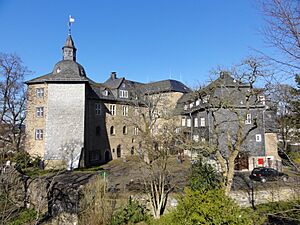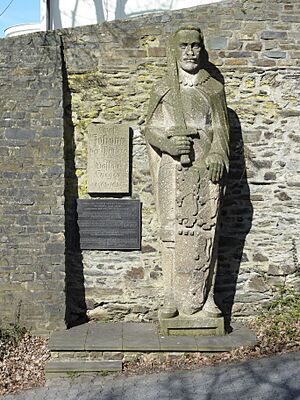John VII, Count of Nassau-Siegen facts for kids
Quick facts for kids
John VII, Count of Nassau-Siegen
|
|
|---|---|
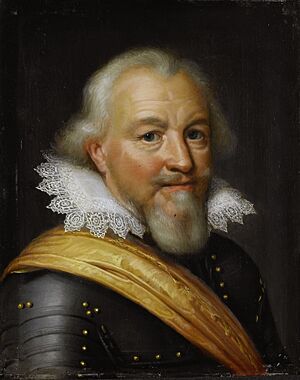
Count John VII the Middle of Nassau-Siegen. Studio of Jan Antonisz. van Ravesteyn, c. 1610–1620. Rijksmuseum Amsterdam.
|
|
| Count of Nassau-Siegen | |
| Coat of arms | 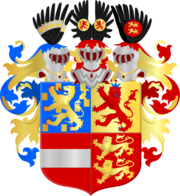 |
| Reign | 1606–1623 |
| Predecessor | John VI the Elder |
| Successor | John VIII the Younger |
| Full name |
John VII the Middle, Count of Nassau-Siegen
|
| Native name | Johann VII. der Mittlere Graf von Nassau-Siegen |
| Born | Johann Graf zu Nassau, Katzenelnbogen, Vianden und Diez, Herr zu Beilstein 7 June 1561 Siegen Castle |
| Died | 27 September 1623 (aged 62) Siegen Castle |
| Buried | 5/15 November 1623 St. Nicholas Church, Siegen Reburied: 29 April 1690 Fürstengruft, Siegen |
| Noble family | House of Nassau-Siegen |
| Spouse(s) |
|
| Issue Detail |
|
| Father | John VI the Elder of Nassau-Siegen |
| Mother | Elisabeth of Leuchtenberg |
| Occupation | Colonel general of the Palatinate Commander-in-chief of the Swedish army |
John VII the Middle of Nassau-Siegen (born June 7, 1561 – died September 27, 1623) was a powerful figure in his time. He was a Count of Nassau-Siegen, a small territory in what is now Germany, starting in 1606. John VII was also the founder of the House of Nassau-Siegen, a branch of the famous House of Nassau.
He was known as one of the most important military thinkers of his era. He came up with many new ideas and inventions for warfare. His book, the Kriegsbuch, contained all the military knowledge of his time. It also included many fresh ideas that helped reform the Dutch States Army. His cousin, Maurice, Prince of Orange, used many of John's ideas. John served in the Dutch States Army and was a top commander for both the Palatinate and the Swedish army. His reputation spread far beyond his home country. John also worked as a mediator, helping to solve problems between different groups, just like his grandfather, William the Rich, had done.
| Top - 0-9 A B C D E F G H I J K L M N O P Q R S T U V W X Y Z |
Biography
John was born at Siegen Castle on June 7, 1561. He was the second son of Count John VI the Elder of Nassau-Siegen and his first wife, Countess Elisabeth of Leuchtenberg.
John first went to school in Siegen. In 1576, he attended Heidelberg University with his older brothers and his cousin, Maurice of Nassau. However, he left the university the next year because his father asked him to. John didn't mind leaving because he found "studying not graceful." He quickly became involved in managing his father's county, including its money and military matters.
John the Elder wanted his son to marry someone wealthy to improve the family's finances. But John the Middle had already fallen in love. His father respected his wishes and did not try to change his mind. This shows how well the father and son got along. In 1581, John married Countess Magdalene of Waldeck-Wildungen. This marriage helped strengthen ties with other noble families, even without a lot of money.
Military Career
Early Military Experience
John's first experience in a military campaign was in 1583. He served under Count Palatine John Casimir. During this time, John saw how armies of hired soldiers worked. His father had often talked about the problems with these types of armies.
From 1584, John worked on making the castles of Nassau and Dillenburg stronger. His father, John the Elder, was reforming the military. He introduced a system where all men had to serve in the army. John the Middle made sure these men were well-trained.
Innovations in Military Training
John believed that soldiers should not be sent into battle without proper skills. He made sure the men were trained well. He ordered that all soldiers should have the same type of rifle with the same size bullet. This way, they could share bullets if needed. He also created special uniforms for the soldiers. This was a new idea at the time. John knew that wearing a uniform would make the men feel more like real soldiers.
The soldiers from Siegerland wore a brown hat with a feather. They also had a yellow gambeson (a padded jacket) and a red overcoat with a blue lining. Their trousers and socks were blue. This uniform was similar to what the Siegen marksmen's guild had worn for a long time.
John also invented the "foot drill" for weapons training. This was a way for soldiers to practice handling their weapons over and over. The men liked this because they saw how much faster and better they became. In Nassau, especially in Siegerland, people did not protest against serving in the army. They felt that fighting for the freedom of the Netherlands was their own fight.
Service in the Dutch Army
John joined the Dutch Revolt in 1592. He took part in the sieges of Steenwijk and Coevorden. He was very close to Prince Maurice, like a brother. They had grown up together. John showed Maurice and his brother William Louis his ideas for military training. At first, they thought his ideas were unnecessary.
But soon, Maurice realized that the soldiers from Nassau-Siegen were better trained than the Dutch soldiers. John's training methods were then used in all the army bases of the United Provinces. John also invented a new type of mortar and special fiery bullets. These were made in Siegen. They were tested during the Siege of Groenlo in 1597 and caused a lot of damage.
Military Theorist and His Influence
John wrote down his ideas as they came to him. He called his notes things like Observationes and Kriegsbuch. This Kriegsbuch contained all the military knowledge of his time. But it also had many completely new ideas. These ideas ranged from how to build large forts to how to arrange a 'secret chamber'. John's military writings helped the Dutch States Army become very strong. They were a big reason for their victories. His writings were so important that they were published again in 1973. John was one of the most important military thinkers of his time. His fame spread far beyond the Holy Roman Empire.
Leading the Swedish Army
During a big conflict called the Counter-Reformation, King Sigismund III of Poland and Sweden was a Catholic. His uncle, Duke Charles of Södermanland, was a Calvinist and opposed Sigismund. John believed that Protestants should support Charles. So, with permission from other Protestant nobles, he traveled to Livonia (a region in Eastern Europe).
He first visited his brother William Louis in Friesland. Once William Louis approved and John knew his home was safe, he went to meet Charles. They met in Pernau on July 16, 1601. Charles immediately offered John the top command of his army. John accepted, even though he wasn't very eager, but only for three months. The Swedish army was in very bad shape. For example, the foot soldiers had terrible weapons. John quickly designed and ordered the making of spiked carts. These carts were pushed in front of the infantry and protected them from attacking cavalry. These spiked carts were kept in the Siegen arsenal for many years.
After three months, John had won some small battles and captured supplies from the Poles. But he couldn't finish the Siege of Riga. Charles begged him to stay longer. John agreed. Soon after, the weather became extremely cold. Within six weeks, 40,000 people died from freezing or starvation. This included 4,500 of the 6,000 foot soldiers from Nassau. John was persuaded to stay again. But then, the ice melted, and a mutiny (rebellion by soldiers) stopped all military actions. John tried to get money to pay the troops, but it was no use. He had even pawned his own jewellery to pay the soldiers. Finally, he truly resigned. Charles provided a Swedish naval ship for his journey home. But the ship was stuck on Bornholm for a long time due to bad storms. The Swedes still owed John 18,000 guilders, even 29 years later!
Despite the difficult journey, John found something good. He met the youngest daughter of Duke John II the Younger of Schleswig-Holstein-Sonderburg. He married her in 1603. His first wife had died in 1599.
Service for the Palatinate
In 1599, Frederick IV offered John the job of colonel general. His task was to reorganize the country's defenses. In 1610, John commanded the Palatine Union troops.
When the Upper Palatinate was in danger, John quickly gathered thirteen companies of cavalry and six companies of foot soldiers. Just his presence was enough to stop the enemy from attacking. After this, the city of Nuremberg gave him a special welcome, "as otherwise does not happen lightly and happens to only a few."
In 1621, he organized the defense of the Palatinate against the Spaniards. However, the Spanish army put pressure on Nassau. This forced John to leave early, which ruined his life's work.
Champion of Protestant Unity
John was a strong supporter of Protestant unity. He wanted Protestants to work together against the Counter-Reformation and the Habsburgs. He didn't always have a lot of political power, but he worked hard. For example, in 1598, he seriously wanted to suggest that his cousin Maurice of Nassau be elected as the German king.
One important Protestant leader was Fürst Christian I of Anhalt-Bernburg. Like John, he wanted a big Protestant alliance. Holy Roman Emperor Rudolf II tried to win Christian over with promises. But Christian stayed with the Protestants, and John was given credit for this. Christian and John became good friends. They wanted to convince Joachim Frederick of Brandenburg to join the Protestant cause. To do this, they wanted to help him get control of the disputed Jülich-Cleves-Berg. Landgrave Maurice of Hesse-Kassel also joined them. In 1603, Maurice married Juliane, John's 16-year-old daughter.
On March 25, 1609, Duke John William of Jülich-Cleves-Berg died without children. Several groups claimed his land. John wanted to prevent a war between the Protestant claimants. He managed to get Wolfgang William of Neuburg and John Sigismund of Brandenburg to agree to work together. Both asked John to lead their troops if they had to fight. John also became a colonel for the Landesrettungsverein (a defense group). He continued his grandfather's role as a successful mediator.
In September 1610, John represented the Protestant states. He negotiated with Maximilian I of Bavaria, the leader of the Catholic League. They reached an agreement that satisfied both sides. In 1615, he helped settle a dispute between the city of Brunswick and Duke Frederick Ulrich of Brunswick-Wolfenbüttel.
When the young Frederick V was asked to become King of Bohemia, he discussed it with John and Christian I. Frederick accepted the crown, becoming the "Winter King." John then prepared the Palatinate for defense. He also made plans to strengthen the Rhine river defenses and modernize forts. He had to prepare defenses for several duchies, even though he had refused a higher military position.
Count of Nassau-Siegen

When his father died on October 8, 1606, John became Count along with his brothers. On March 30, 1607, the brothers divided their lands. John received Siegen and several other towns. The brothers also signed a treaty about who would inherit the lands. This treaty said that future heirs could not change their religion from the Reformed confession. Since then, John lived in Siegen Castle, which he had repaired.
John had many worries about his sons from his first marriage. John Ernest and Adolf were known for gambling and spending too much on fancy clothes. John wrote letters to them, telling them to be careful with money. He was so worried that he even thought his son Adolf's death in 1608 was a punishment from God.
In 1610, John attended a meeting of princes in Schwäbisch Hall. He represented the House of Nassau and other noble families. In 1612, he traveled to Frankfurt with his brother George and two sons. They went for the coronation of Matthias as Roman King. John was the first to cut a piece of roast beef in front of the city hall and bring it to the king's table.
He signed new agreements with his brothers in 1611 and 1613 about their family lands. In 1618, he made a special agreement with his brother George about not claiming a part of Nassau-Dillenburg that was rightfully his. In 1619, they also agreed on debts related to William the Silent. Finally, they signed a treaty about dividing lands and debts after their brother William Louis died.
When the Thirty Years' War began, John remained loyal to his old allies in the Palatinate. He stayed there as commander-in-chief. This put his own country in danger from the imperial troops. His brothers had to strongly urge him to leave his friend's cause and return to Siegen. Once home, he worked hard to protect his town and country.
Founding the Military Academy
John wanted to train good leaders for a people's army for the Protestant cause. This led him to found the Kriegsschule (military academy) in Siegen in 1616. This was likely the world's first military academy. The princes he asked for money didn't give him any. Even though he was deep in debt from supporting the Dutch Revolt, he still opened the school. His wife, Margaret, even wrote to King Christian IV of Denmark asking for an old debt to be paid. Perhaps Danish money helped open the school. However, the Thirty Years' War started too soon, and the school in Siegen could not continue.
Interestingly, two of John's descendants later achieved what he couldn't. Count William of Schaumburg-Lippe founded a famous military academy in Portugal. He also started an academy for artillery and military engineering in Schaumburg-Lippe. One of its most famous students was Gerhard von Scharnhorst. Another descendant was Friedrich Wilhelm von Steuben. He helped organize the Continental Army during the American Revolution and was an important helper to George Washington.
Succession Plans and Family Disputes
When John received the County of Nassau-Siegen in 1607, it was a small country. It had about 9,000 people and earned about 13,000 guilders a year. John decided it should not be divided again. He wrote a will and testament saying that only the oldest son would rule. The other children would receive money or positions instead.
John was a strong Protestant. It was very painful for him when his second son, John the Younger, became Catholic in 1613. This event saddened John's last years. In a later addition to his will (a codicil) in 1613, he clearly stated that his heirs must keep the land Protestant. At first, John the Younger's conversion didn't change the inheritance plan, because he wasn't the oldest son. That was John Ernest.
To his relatives' surprise, John the Younger joined the Spanish army in 1617. This meant he was fighting against the House of Nassau and the Dutch Republic. In the same year, his older brother John Ernest died while serving the Republic of Venice. John the Younger joining the enemy hurt his father as much as his conversion to Catholicism had. This new situation made John wonder if an enemy of Nassau could still be his heir.
On November 15, 1617, John canceled his first will. He didn't want to divide the small country, as that would make it too weak. Instead, he made an agreement with his son on December 31, 1617. John the Younger promised that even though he was Catholic, he would not force his subjects to change their religion. John's brothers advised him to change the inheritance rule. But John trusted his son's word. It saddened both of them that their different beliefs caused such pain.
On December 22, 1618, John wrote a second will. It still kept the rule that the oldest son would inherit everything. But it added a punishment: if "papism" (Catholicism) was introduced, the heir would lose their inheritance. John believed that the Dutch branch of the House of Nassau would help him if his son broke his promise. He asked his cousin Maurice of Orange for help if John the Younger used Spanish or imperial troops in Siegerland. But Maurice and the States General showed no interest. This disappointed John, but he understood that the Netherlands had its own problems. For a while, he even thought about putting a Dutch army in Siegen.
It's not fully clear why John the Middle still distrusted his son. Perhaps John the Younger loudly claimed that no one could stop him from inheriting Nassau-Siegen, because the Emperor and the King of Spain supported him. Maybe John the Middle also knew about the influence of the de Ligne family and Catholic priests on his son. His relatives and other Protestant leaders kept warning him about his son. Only when he was sure his son was influenced by the Jesuits and that a Catholic area in Nassau would endanger Protestants, did he agree to a new will.
On July 3, 1621, he wrote a third will. In this will, he did something he always thought was foolish: he divided the small county of Nassau-Siegen into three parts. This was an act of pure desperation. His three oldest sons, John the Younger, William, and John Maurice, would each get one-third. The city of Siegen would be shared by all three sons.
John the Younger was told about this new will on August 6, 1621. He received a clear explanation of why his father made this decision. On May 9, 1623, two years later, John the Younger protested this will in a letter to the Siegen councilors. He had already complained about his father to the Emperor. When he wrote his protest letter, he probably knew about the Emperor's order. Emperor Ferdinand II officially issued this order on June 27, 1623. It stated that John the Middle, as an ally of the "Winter King" (who was outlawed), was not allowed to make a will. He had to cancel it and appear before an imperial court within two months. It seems John the Younger hesitated to deliver this order to his very ill father.
Death and Burial
John the Middle died at Siegen Castle on September 27, 1623. None of his three sons mentioned in the will were there when he died. William and John Maurice arrived in Siegen on October 13. John the Younger arrived on October 26.
John the Middle had planned a special burial vault for his family in the St. Nicholas Church in Siegen. He had detailed notes for this memorial, including the names and dates of all 25 of his children. But the project was never finished. So, family members who died between 1607 and 1658 were buried in a smaller vault under the church's choir. John the Middle was buried there on November 5/15, 1623.
John the Middle was reburied on April 29, 1690. He and his two wives were moved to the Fürstengruft in Siegen.
Succession Dispute After His Death
Everyone knew there would be a fight when John's will was read on December 11, 1623. John the Younger had the Emperor's order read out. When his brothers weren't impressed, he said, "The Emperor will part us!" He had already gotten another imperial order on November 20, 1623. This order strictly forbade anyone from stopping John the Younger from taking control of the land.
On January 12, 1624, John the Younger was able to be recognized as the ruler by the city of Siegen. He managed this by secretly bringing a group of horsemen into the town through the castle gate during a heavy snowstorm. This way, the town guards didn't see or hear them.
So, John the Younger received the entire inheritance. The parts of the will that gave land to William and John Maurice were ignored. However, on January 13/23, 1624, John the Younger willingly gave William control over the Hilchenbach district and some other villages. Except for John Maurice and George Frederick, the younger brothers only received small payments. From then until 1645, the county of Nassau-Siegen had two governments: one in Siegen and one in Hilchenbach.
This situation changed for a short time (1632–1635) during the Thirty Years' War. John the Younger's brothers, who fought on the Protestant side, rebelled against him.
Count Louis Henry of Nassau-Dillenburg joined the army of King Gustavus II Adolphus of Sweden in 1631. Gustavus Adolphus had come to Germany to help the Protestants in the war. John's widow, Countess Margaret, asked Gustavus Adolphus for help against her stepson, John the Younger. So, on February 14, 1632, the Swedish king ordered Louis Henry to help John Maurice with military support. Louis Henry then took control of Siegen with his soldiers.
The next day, February 29, John Maurice and his brother Henry arrived in Siegen. Just as John the Younger had used his cavalry earlier, John Maurice and Henry, with the Swedish soldiers, talked with the citizens. The citizens felt bound by their oath to John the Younger. After long talks, on March 4, the citizens recognized John Maurice and Henry as rulers. John Maurice gained control of the Freudenberg district and Netphen. William was confirmed in his control of Hilchenbach and also received Ferndorf and Krombach, as his father's will had stated. The city of Siegen only recognized William and John Maurice. They only allowed their older brother, John the Younger, back into shared rule in 1635.
However, John the Younger soon restored the old order. In 1636, he became the sole owner of his father's property again, except for Hilchenbach, which he left to William. He also ruled Siegen alone again. John Maurice was again excluded from ruling the county. However, in 1642, he inherited the territory from his brother William, according to his father's will.
John the Younger died in Ronse on July 27, 1638. His only son, John Francis Desideratus, was born in Nozeroy in 1627. His mother ruled for him until he married in 1651. He tried many times to get control of all of Siegerland. In 1646, he visited the Emperor in Vienna to protest against his uncle John Maurice taking over the county.
On January 22, 1645, John Maurice, along with his brothers George Frederick and Henry, had forcefully taken Siegen Castle. On February 15, the citizens again recognized him as ruler, but only for two-thirds of the county. To end the constant arguments, John Maurice wanted to follow his father's 1621 will exactly. He wanted to give his nephew, John Francis Desideratus, the one-third that was due to him. Before he left for Brazil in 1635, John Maurice had even allowed his subjects to recognize John the Younger as a co-ruler. In 1645, John Maurice gave up his rights to the Freudenberg district to his brother George Frederick.
John Francis Desideratus was not successful with the Emperor in Vienna. Two years later, at the Congress of Westphalia, Emperor Ferdinand III approved John the Middle's disputed 1621 will. This left John Francis Desideratus with only the Catholic one-third, which is still known today as Johannland. John Maurice held the other two-thirds. This was because his brother William had died and left him his share, and George Frederick had given all his rights to John Maurice in 1649. So, John Maurice continued to manage the Freudenberg district.
Understanding the Nickname "the Middle"
In John's time, it wasn't common for ruling counts to have numbers like kings do. When a father and son had the same first name, and the son became an adult, they needed a way to tell them apart. The father was called Johann der Ältere (John the Elder), and the son was called Johann der Jüngere (John the Younger). This is like how we use "Sr." and "Jr." today.
Documents from the 1990s show that John's first wife was called Graf Johan des Jüngern gemahlin frau Magdalena (Count John the Younger's wife, Lady Magdalena). And his son, who died in 1600, was called Graf Johans des Jungern söhnlein Friderich Ludwig (Count John the Younger's little son, Frederick Louis).
But this "John the Younger" also had a son named John. When this third John grew up, calling them "Elder" and "Younger" wasn't enough. So, the youngest was called Johann der Jüngere (John the Younger), and the middle one was called Johann der Mittlere (John the Middle). It wasn't until the 1800s that historians started giving ruling counts numbers. So, Johann der Ältere became John VI, Johann der Mittlere became John VII, and Johann der Jüngere became John VIII.
Marriages and Issue
First Marriage
John the Middle first married Countess Magdalene of Waldeck-Wildungen on December 9, 1581, at Dillenburg Castle. Magdalene (1558 – September 9, 1599) was the youngest daughter of Count Philip IV of Waldeck-Wildungen. She was also the widow of Count Philip Louis I of Hanau-Münzenberg.
John and Magdalene had the following children:
- John Ernest (born October 21, 1582 – died September 16/17, 1617). He was a general in the Venetian army.
- Count John VIII the Younger (born September 29, 1583 – died July 27, 1638). He became Count of Nassau-Siegen after his father in 1623. He married Princess Ernestine Yolande de Ligne in Brussels on August 13, 1618.
- Elisabeth (born November 8, 1584 – died July 26, 1661). She married Count Christian of Waldeck-Wildungen in Wildungen in November 1604.
- Adolf (born August 8, 1586 – died November 7, 1608). He was a captain in the Dutch States Army.
- Juliane (born September 3, 1587 – died February 15, 1643). She married Landgrave Maurice of Hesse-Kassel at Dillenburg Castle on May 21, 1603.
- Anne Mary (born March 3, 1589 – died February 22, 1620). She married Count John Adolf of Daun-Falkenstein-Broich in Dillenburg on February 3, 1611.
- John Albert (born February 8, 1590 – died 1590).
- Count William (born August 13, 1592 – died July 7/17, 1642). He became count in part of Nassau-Siegen in 1624 and a field marshal of the Dutch States army in 1633. He married Countess Christiane of Erbach at Siegen Castle on January 17, 1619.
- Anne Joanne (born March 2, 1594 – died December 1636). She married Johan Wolfert van Brederode at Broich Castle on June 19, 1619.
- Frederick Louis (born February 2, 1595 – died April 22, 1600).
- Magdalene (born February 23, 1596 – died December 6, 1662). She married Bernhard Moritz Freiherr von Oeynhausen-Velmede in August 1631. She later married Philipp Wilhelm Freiherr von Innhausen und Knyphausen on August 25, 1642.
- John Frederick (born February 10, 1597 – died 1597).
Second Marriage
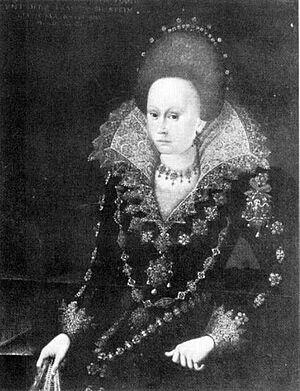
John the Middle remarried on August 27, 1603, at Rotenburg Castle. His second wife was Duchess Margaret of Schleswig-Holstein-Sonderburg (born February 24, 1583 – died April 10/20, 1658). She was the youngest daughter of Duke John II the Younger of Schleswig-Holstein-Sonderburg.
John and Margaret had the following children:
- Fürst John Maurice (born June 18, 1604 – died December 10/20, 1679). He was a governor in Dutch Brazil (1636–1644) and a stadtholder (governor) of several areas. He became a count in part of Nassau-Siegen in 1645 and was made a prince in 1652.
- George Frederick Louis (born February 23, 1606 – died October 2, 1674). He was a commander and governor. He was also made a prince in 1664. He married Mauritia Eleonora of Portugal in The Hague on June 4, 1647.
- William Otto (born June 23, 1607 – died August 14, 1641). He was an officer in the Swedish army.
- Louise Christine (born October 8, 1608 – died December 29, 1678). She married Philippe François de Joux dit de Watteville in Nozeroy on July 4, 1627.
- Sophie Margaret (born April 16, 1610 – died May 8/18, 1665). She married George Ernest of Limburg-Stirum at Wisch Castle on January 13, 1656.
- Henry (born August 9, 1611 – died October 27/November 7, 1652). He was a colonel in the Dutch States Army and a governor. He married Countess Mary Magdalene of Limburg-Stirum at Wisch Castle on April 19/29, 1646.
- Mary Juliane (born August 14, 1612 – died January 21, 1665). She married Duke Francis Henry of Saxe-Lauenburg in Treptow on December 13, 1637.
- Amalie (born September 2, 1613 – died August 24, 1669). She married Herman Wrangel af Salmis in Alt-Stettin on April 23, 1636. She later married Count Palatine Christian Augustus of Sulzbach in Stockholm on March 27, 1649.
- Bernhard (born November 18, 1614 – died January 6, 1617).
- Christian (born July 16, 1616 – died April 1/11, 1644). He was a colonel in the Imperial Army. He married Anna Barbara von Quadt-Landskron-Rheinbach around 1641.
- Catharine (born August 1, 1617 – died August 31, 1645).
- John Ernest (born November 8, 1618 – died November 23, 1639). He was a naval officer.
- Elisabeth Juliane (born May 1, 1620 – died May 13, 1665). She married Count Bernhard of Sayn-Wittgenstein-Berleburg-Neumagen in Siegen on August 9/19, 1647.
Images for kids


